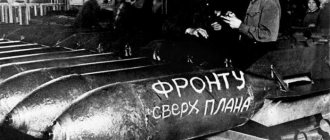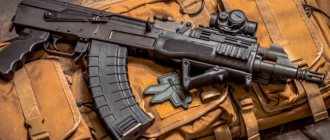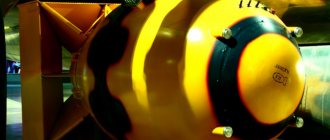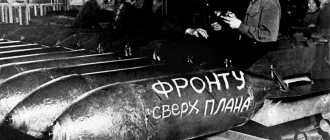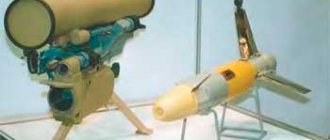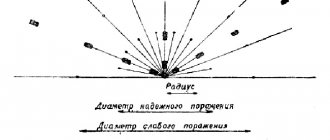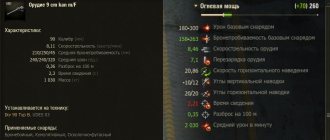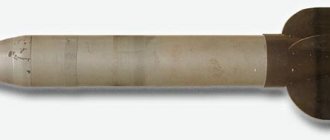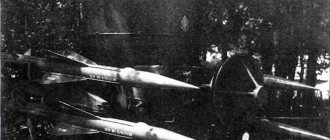In connection with the operation that the Russian aerospace forces are conducting in Syria, the press increasingly mentions the use of an unusual type of ammunition - concrete-piercing or bunker-busting bombs. What kind of bombs are these, what are they for, and how do they differ from other types of aircraft munitions?
A concrete-piercing bomb (BetAB) is a type of aviation munition that is used to destroy various shelters (mainly protected by reinforced concrete structures), as well as airfield runways.
In fact, concrete-piercing bombs are a type of high-explosive aerial bombs, which are distinguished by thicker walls (usually made of high-strength alloy steel) and a special fuse. Concrete-piercing bombs have a large caliber: from 500 to 1 thousand kg (for example, the Russian BetAB-500 bomb), sometimes even more powerful ammunition is used.
In classical warfare, BetABs are used to destroy enemy bunkers, command posts, pillboxes, coastal batteries, and mine installations. However, concrete-piercing bombs are also successfully used in counter-guerrilla warfare, which has been repeatedly proven by practice in recent years.
In Afghanistan and Syria, rebels use a powerful network of underground communications, which are sometimes located at quite a decent depth. The Afghan Mujahideen actively used (and continue to do so) natural caves for their bases and strongholds. Over the years, Lebanese Hezbollah fighters have created an extensive network of tunnels on the Israeli border. Moreover, these are not just hastily dug holes in the ground; many of these tunnels are securely fortified, equipped with electricity and other communications.
To destroy all of the above objects, concrete-piercing bombs are often used.
The heyday of these aircraft munitions came at the end of World War II: Allied aviation used giant bunker-busting bombs (weighing up to 10 tons) to destroy the concrete shelters of Nazi submarines. After the advent of nuclear bombs and advanced missile weapons, developments in this direction became less relevant. However, in recent decades there has been a real “renaissance” of bunker-busting ammunition.
Currently, the United States, Russia and Israel are actively developing anti-bunker ammunition.
There are two main types of concrete bombs. The first group includes free-fall BetABs, which are usually used from great heights. Thanks to this, the ammunition gains greater speed, due to which it can hit deeply located and well-protected shelters. The second group of concrete-piercing aerial bombs includes ammunition with jet accelerators. They can be used for bombing from low altitudes. Often such bombs have a parachute, which stabilizes the flight of the ammunition at a certain angle. Then the parachute is fired and the jet engine is turned on.
One of the directions for the development of this type of aviation ammunition is the creation of cluster bombs with damaging concrete-piercing elements. Such aerial bombs are especially effective against enemy runways and are guaranteed to destroy runway coverage over large areas at once. An example of such an aerial bomb is the Russian RBK-500U.
The improvement of unitary concrete-piercing aerial bombs also continues. Much attention is paid to improving the ratio between the mass of the ammunition and its cross-section. In addition, research is underway on new materials for the housing.
Main characteristics of aerial bombs
- Caliber is the nominal mass of an aerial bomb with established geometric dimensions, expressed in kilograms or pounds (in Russia and the USSR until the early 1930s - in poods). For aerial bombs of the USSR and Russia, the caliber is indicated in the bomb symbol after the type name.
- Filling factor - the ratio of the mass of the equipment (explosive) to the total mass of the bomb. It varies in the range from 0.058 (BrAB-200DS) – 0.069 (AO-10sch model 1940) to 0.83 (GBU-43/B). The highest filling coefficient is for high-explosive surface explosion bombs, the lowest for jet (with a rocket accelerator) armor-piercing and fragmentation bombs.
- The aerodynamic characteristics of an aerial bomb are determined by its ballistic coefficient. In the USSR and Russia the standard characteristic
that determines this coefficient is the value of
the characteristic time of the fall of an aerial bomb
- the time of fall of an aerial bomb dropped in horizontal flight by a carrier at a speed of 40 m/s and an altitude of 2000 meters. - Indicators of the effectiveness of destruction of aerial bombs: Particular - determining the specific nature of the damage to the target: the radius and depth of the explosion crater, the thickness of the armor penetrated by the bomb, the radius of fragmentation damage, the area of the affected area for high-explosive bombs, etc.
- Generalized - determining the required number of hits on a target to destroy it or disable it for a given time, the reduced area of destruction, etc.
“The very best” among aerial bombs[edit | edit code]
Conventional air bombsedit | edit code
Grand Slam
- PTAB-2.5-1.5 is the most popular aerial bomb of the USSR during the Great Patriotic War.
- FAB-100 - the main aerial bomb of the USSR during the Great Patriotic War.
- FAB-9000M-54 is the heaviest (together with the armor-piercing BrAB-9000) and powerful non-nuclear aerial bomb in the USSR.
- Grand Slam (“Big Cotton”) is the most powerful (non-nuclear) and heaviest (9979 kg) aerial bomb of the Second World War.
- GBU-43/B Massive Ordnance Air Blast (MOAB) - “Massive shock wave ammunition”, common backronym: Mother Of All Bombs - “Mother of all bombs”; is the most powerful non-nuclear aerial bomb in the world (explosive mass - 8480 kg), brought into service. It was also the heaviest (9500 kg) guided aerial bomb in the world before the GBU-57 entered service and remains the most powerful of such bombs. First used in combat on April 13, 2022.
- GBU-57 Massive Ordnance Penetrator (MOP) - the heaviest (13609 kg) non-nuclear aerial bomb in history, brought into service (the first batch of 20 bombs was delivered to the United States Air Force in November 2011 G.). Also the heaviest guided aerial bomb in the world.
- The T-12 Cloudmaker is the heaviest (caliber - 43,600 pounds or 19,777 kg) non-nuclear (high-explosive) aerial bomb in history. Its body was used to manufacture the “uranium superbomb” Mk.18 and the thermonuclear aerial bomb Mk.17.
- ODAB-9000 [ source not specified 3639 days
] (“Kuzkin’s father”, “Daddy of all bombs”) - a high-power volumetric detonating aerial bomb. It is considered the most powerful non-nuclear weapon in the world (44,000 kg of TNT equivalent). - KhB-2000 is the heaviest chemical aerial bomb in history.
- (“Viper Strike”) is the smallest (19 kg) serial controlled aerial bomb in the world.
- Small Tactical Munition (STM) Pyros ("Pyro") is the smallest (6.13 kg) guided aerial bomb completed ready for delivery.
- Shadow Hawk (“Ghost Hawk”) is the smallest (5 kg) guided aerial bomb in the world.
- AO-8m6sch-fs is the smallest (6.67 kg) high-explosive aerial bomb in history.
- BLU-39 (chemical) is the smallest (about 82 grams) aerial bomb in history, brought into service.
- Bat bomb (“Mouse bomb”, incendiary) is the smallest (17 grams) aerial bomb in history (it was produced in an experimental series, but did not enter service). It was assumed that the carriers of these bombs would be bats dropped from airplanes in special self-unpacking containers.
Nuclear bombsedit | edit code
- “Little Boy” (eng. Mk.I “Little Boy”) - the first nuclear bomb dropped on Japan (Hiroshima) on August 6 (8:15).
- “Fat Man” (eng. Mk.III “Fat Man”) is the second nuclear bomb dropped on Japan (Nagasaki) on August 9 (11:02).
- RDS-1 (“product 501”) - the first Soviet nuclear bomb.
- Mk.18 (“uranium superbomb”) is the most powerful (500 kilotons) and heaviest “classical” (only based on the nuclear decay reaction) nuclear bomb, brought to mass production and adoption. An analogue of the thermonuclear Mk.17, but in pure uranium equipment.
- RDS-6s (“product 6”) is the world’s first thermonuclear aerial bomb (and the world’s first thermonuclear weapon in general).
- Mk.17 is the most powerful (15 megatons) and heaviest (21,000 kg) thermonuclear bomb brought to mass production and adoption.
- AN602 (“Tsar Bomba”, “Kuzka’s Mother”, “Ivan”) is the most powerful (58.6 megatons) and heaviest (weight 26.5 tons with a parachute system) bomb in the history of mankind.
- Blue Danube was the first nuclear weapon adopted by the British Royal Air Force.
- Orange Herald (“Orange Herald”) is the most powerful (700 kilotons) tested ammunition, the energy release of which was provided entirely by the nuclear fission reaction.
Birth story
While aviation was in its infancy, the bomber's onboard weapons included everything from hand grenades to packs of forged steel arrows.
Flechette - it was with these small forged darts, the size of a pencil, that the history of modern aviation weapons began
However, as the aircraft matured, its weapons also became more mature. The infantry did not stand still either - it dug deeper and deeper into the ground, covering communications, warehouses and firing points with a powerful cap of strong concrete, inaccessible to destruction by standard means. Something had to be done about this, and they did it.
We have
The first serious problems for the then Red Army arose during the Winter War with the Finns. Then the “indestructible and legendary” tightly rested against the solid fortifications of the Mannerheim line, and was able to break through them only by densely filling the ditches and trenches with the bodies of soldiers.
It was not possible to take the line technically and with more or less decent losses, using only equipment, tactics and weapons correctly. In particular, due to the lack of special aviation ammunition designed to destroy reinforced concrete, which was widely used in Finnish fortifications.
The long-term firing points of the Mannerheim line, made according to all the rules of military fortification, still amaze the imagination with their power and thoroughness in our time.
Based on the results of the winter campaign in Finnish forests and swamps in 1940, the BetAB-150 DS product, the first domestic concrete-piercing bomb, appeared from the bowels of the State Specialized Design Bureau, GSKB-47.
Due to the lack of technology for creating high-strength aerial bomb casings, the designers took a 203 mm howitzer artillery shell as a basis. The new ammunition had a solid-state jet upper stage and a warhead containing 14.5 kg of high explosive.
The Ilyushin Il-4 long-range bomber, a rather ordinary machine in all respects, was intended to destroy well-protected targets and was the main carrier of the BetAB-150DS
Judging by state test reports, the ammunition had a penetration depth of the rock pillar of about 1600 mm and a satisfactory high-explosive effect. The barrier action, apparently, was so satisfactory that immediately after the war, using the developments of military specialists of the Third Reich, the domestic industry was able to quickly develop, test and adopt specialized concrete-piercing ammunition, a number of which remain in service to this day.
And they
The Anglo-American allies were also faced with the need to confidently destroy reinforced concrete structures, but under slightly different conditions. Almost the entire year of 1942 on the Western Front passed under the sign of the War for the Atlantic.
It was in the cold and harsh waters of the North Atlantic Ocean that the main transcontinental communications connecting America and the Old World took place. It was there that German submarines frantically tore at the Allied convoys, huddled in evil “wolf packs.”
The combined forces of the Allies tried to solve the problem radically - by destroying the hornet's nest itself, the base of the Kriegsmarine submarine forces in the Baltic Kiel.
This is approximately the general appearance and design of German submarine shelters in the Baltic.
The base itself was connected to the open sea by a long and narrow canal and was reliably covered from the sea by both the fleet and coastal artillery. But the loophole remained in the air.
True, the boats of Admiral Doenitz themselves were securely hidden in reinforced concrete hangars, these hangars, and at the same time their inhabitants, it was decided to thoroughly feel. The tool was supposed to use a specially designed 5-ton “Bigger” bomb and a 10-ton “Big Firecracker”.
There is a legend that designer Wallace assembled the first copy of the newest British five-ton concrete-piercing bomb with his own hands
You can read about all the vicissitudes of the grandiose confrontation between Nazi concrete and Allied explosives in specialized literature, but we should note that the Anglo-Saxons accumulated tremendous experience and created a first-class design school, which is still successfully operating today.
Recalculate floors
The topic of more effective bunker-busting weapons was further developed. In combat operations in Yugoslavia (Operation Allied Force), the US Air Force used the “Advanced Unitary Penetrator” (English abbreviation AUP) warhead BLU-116. In terms of dimensions, it exactly corresponded to the good old BLU-109, but the projectile itself, which pierced concrete, had a smaller caliber. At the same time, it was enclosed in a casing of larger diameter - made of aluminum alloy. To make the “rod” itself, a hard alloy of steel, nickel and cobalt grade 9430 M was used. The BLU-116 warhead was used in the laser-guided bombs GBU-24 C/B and GBU-24 D/B
The main thing that distinguished the new generation projectile was the ability to penetrate concrete obstacles up to 6 m thick and, importantly, the ability to work with concrete structures of complex design. BLU-116 was equipped with HTSF (FMU-157D) - the so-called smart fuze for hard targets
Thanks to installed sensors and a microprocessor, the fuse can “count floors,” which it perceives as a sequence of obstacles and voids overcome. In this way, the bomb can be programmed to detonate explosives at a specific level of a concrete bunker.
The battles between the Americans and Saddam have long since ended, and the Balkans are relatively quiet. These days, one of the most burning topics is Iran's nuclear program, which the United States and some of its allies are trying to stop by any means, not excluding force. In the West, it is believed that the Islamic Republic of Iran has already hidden or is about to hide its dual-use nuclear secrets under a layer of stone and concrete, in secret mountain bunkers. Realizing that the Iranians have likely learned the lessons of Saddam and will take better care of preserving their gains than their enemy neighbor Iraq, America has prepared a new surprise.
No less than 60 m of reinforced concrete can be penetrated by a Boeing superbomb called GBU-57, or Massive Ordnance Penetrator (MOP). This giant is comparable in length to the GBU-28 (6.2 m), but cannot be compared with it in terms of body thickness (80 cm versus 35). The cigar-shaped bomb weighs 13.6 tons, which is several tons higher than any of the concrete-piercing superbombs of World War II and several times heavier than the GBU-28 (2268 kg). The MOP is laser-guided with GPS support, and will be delivered to the target by the radar-stealthy B-2A Spirit strategic bomber. In November last year, it was announced that the Air Force had delivered the first batch of heavy-duty bombs out of a total order of 20, indicating serious preparations for a possible strike on buried targets. It is unknown whether all the bombs are intended for Iran alone, Iran and North Korea, or whether there are other potential recipients.
PROMISING CONCRETE-BEATING AIRCRAFT AMMUNITION FROM LEADING NATO COUNTRIES
The ministries of defense of the USA, Great Britain, Germany and France in the early 1990s developed requirements for ammunition with increased penetrating ability. Such BP are required to destroy important underground enemy objects protected by reinforced concrete floors up to 6 m thick. Currently, only one type of ammunition capable of hitting such objects is produced in sufficient quantities. These are BLU-113, part of the GBU-28 and -37 guided bombs (UAB) (weight 2,130 kg), which can be placed on the ventral hardpoint of the F-15E tactical fighter and in the weapons bay of the B-2A strategic bomber. Thus, the leadership of the armed forces (AF) of the listed and some other countries is interested in creating new, lighter ammunition of this type, which will make it possible to use them from other carriers that have restrictions on the weight and size of the ammunition placed on the pylon.
European and American experts have put forward two concepts for creating concrete-piercing ammunition weighing no more than 1,000 kg. According to the European concept, the development of a new type of tandem concrete-piercing warheads (TCCU) is proposed. The RAF already has concrete-piercing submunitions with tandem placement of shaped charge and high-explosive charges - SG-357, which are part of the JP-233 non-resettable aviation cassette and are used to damage runways. However, due to their small size and low power, SO-357 charges are not capable of hitting deep underground objects. The proposed standard TBBC of a new design consists of an optical non-contact fusing device (ONVU) and one or more shaped charges (CH) located in front of the main warhead (MC). The housing of the main unit must be made of durable materials based on tungsten steel with the addition of other heavy metals with similar properties. An explosive charge (EV) is placed inside, and a programmable fuse device (PU) is located in the bottom part. According to the developers, the loss of kinetic energy of the OB as a result of its interaction with detonation products does not exceed 10% of the initial value. The detonation of a shaped charge is carried out at the optimal distance from the target according to data from the ONVU. The free space formed as a result of the interaction of the cumulative jet (CS) and the barrier material includes the CBC, which, after hitting the remaining part of the barrier, explodes inside the object. Laboratory studies have confirmed that the depth of penetration of concrete-piercing ammunition into a barrier depends mainly on the impact speed, the physical parameters of the interacting bodies (density, hardness, tensile strength, etc.), the M/S parameter (the ratio of the mass of the warhead and the cross-sectional area), and for TBBC - also on the diameter of the shaped charge.
During testing of this TBBC weighing up to 500 kg (impact speed 260 – 335 m/s), it was found that they are capable of penetrating medium-density soil to a depth of 6–9 m and then piercing reinforced concrete slabs with a total thickness of 3–6 m. In addition, , ammunition with such warheads can successfully hit targets with lower kinetic energy values than conventional concrete-piercing ammunition, more acute angles of approach (the angle between the tangent plane to the point of intersection of the longitudinal axis of the ammunition with the target surface at the moment of impact and the axis itself) and less acute angles of attack (the angle between the longitudinal axis of the ammunition and the velocity vector of its center of mass at the moment of impact).
American specialists have taken the path of improving unitary concrete-piercing combat units (UBCU). The peculiarity of the use of ammunition with such warheads is that they need to impart significant kinetic energy, as a result of which the requirements for the strength of the hull increase. When developing new ammunition, extensive scientific research was carried out to create especially strong alloys for the manufacture of the body and to find its optimal geometric dimensions, for example, the shape of the nose. To increase the value of the M/S parameter (which will provide greater penetrating power), it is proposed, with the same overall dimensions of existing ammunition, to increase the thickness of their shell by reducing the amount of explosives in the warhead. The advantages of the new unitary warheads include the relative simplicity of the design and their lower cost compared to the TBBCh. As a result of the tests, it was found that the new type of UBBC (weight up to 1,000 kg, BP speed is 300 m/s) can penetrate medium-density soil to a depth of 18–36 m and pierce reinforced concrete slabs with a total thickness of 1.8–3. 6 m. Work continues to increase the value of these indicators.
European and American specialists have created and successfully tested new models of tandem (BROACH, Lancer, MEPHISTO) and unitary (AUP-3, J-1000) concrete-piercing warheads (see table). Ammunition with such warheads is designed to destroy enemy underground communications, highly protected ground targets, missile launchers, and bridge structures. They are supposed to equip air-to-ground guided missiles and guided bombs.
The concrete-piercing warhead MEPHISTO (Multi-Effect Penetrator High Sophisticated and Target Optimized, also known as “Effector”) was developed by the Franco-German company TDA/TDW by order of the German Ministry of Defense to equip KEPD-350 and -150 air-to-air guided missiles -Earth". The TBBCH uses an electromechanical safety-actuating mechanism that is part of the PIMPF (Programmable Intelligent Multi-Purpose Fuze) control unit, made using SHAFT technology (Smart Hard target Attack Fuzing Technology). A distinctive feature of this device is that it is capable of recognizing a large number of obstacles of different types by comparing the data stored in its electronic memory with information that comes from the built-in accelerometer, which measures shock accelerations. This allows you to count the number of obstacles having different densities and hardness, as well as the distance traveled, and correctly calculate the time of detonation of the main explosive charge.
The explosive device can be programmed both on the ground and in flight for air or underground detonation, which makes it possible to destroy ground-based area targets. In the event of an air blast, both charges are initiated simultaneously. Concrete-piercing warheads BROACH (Bomb Royal Ordance Augment Charge) and Lancer were developed by the British (BROACH) and Thomson-Thorn (Lancer and BROACH), respectively. In its design and principle of operation, the ammunition is similar to the MEPHISTO TBC. As Western experts note, a distinctive feature of the BROACH TBBC is that it includes the FMU-157/B HTSF (Hard Target Smart Fuze) programmable fusing device used in the GBU-28/B UAB.
Currently, specialists are working on the creation of a new MEHTF (Multi Effect Hard Target Fuze) device, taking into account the experience gained during the creation of the HTSF device. The new VU is smaller in size and cost, as well as has wider possibilities of use. As Western experts emphasize, the BROACH warhead can be effectively used from both low and medium altitudes. The BROACH TBBCH production technology allows for significant variations in its weight and size characteristics. In particular, three warhead variants were created: with a diameter of 450 mm (for equipping Scalp and Storm Shadow air-to-ground long-range air-to-ground guided missiles), 300 mm (a variant of the AGM-154C JSOW guided aviation cassette without submunitions ) and 127 mm (under a 155 mm artillery shell). The diameter of the third version of the warhead allows the BROACH to be used in missile weapons launched from a recoilless launcher.
Unitary concrete-piercing warhead AUP-3 (BLU-116/B), developed in 1997 by order of the US Air Force by the American corporation Lockheed Martin for installation on the GBU-24 UAB and the AGM-86D air-launched cruise missile. The warhead body is made of high-strength nickel-cadmium steel (grade 1410) and, with weight-dimensional characteristics similar to the BLU-109/B warhead, has almost twice the penetrating power. The FMU-157/B HTSF VU is located in its bottom part. According to the developers, the presence of a small mass of explosives contained in the BP body is intended to increase its penetrating ability and minimize the damage caused to the environment in the event of an explosive device getting into underground warehouses of chemical, biological and nuclear weapons. The J-1000 warhead was created in 1995 by order of the US Air Force for installation on the AGM-158 JASSM missile and other air-to-ground missiles. The body is made of a metal alloy based on tungsten steel. The ammunition is used to equip the Pave Way UAB with the FMU-143 A/B or FMU-152B ammunition. The FMU-152B explosive device can be programmed in flight by the pilot for underground or air detonation.
| MAIN CHARACTERISTICS OF PROMISING CONCRETE-PILLING WAR UNITS* | ||||
| Warhead name or designation | Weight, kg | M/S, kg/sq.cm | Weight of explosives (short circuit/obch), kg | Depth of penetration into the barrier (soil + reinforced concrete), m at BP speed equal to 300 m/sec |
| MEPHISTO | 500 | 0,92 | 45/56 | 6,1 — 9,1 + 3,4 — 6,1 |
| BROACH | 450 | 0,77 | 91/55 | 6,1 — 9,1 + 3,4 — 6,1 |
| "Lancer" | 450 | 0,77 | 91/55 | 6,1 — 9,1 + 3,4 — 6,1 |
| AUP-3 | 750 | 1,3 | 55 | 24,4 — 36,6 + 2,4 — 3,4 |
| J-1000 | 435 | 0,64 | 109 | 6,1 — 24,2 + 1,2 — 2,1 |
| BLU-109 | 890 | 0,81 | 243 | 12,2 — 30,5 + 1,5 — 2,4 |
| BLU-113 | 2130 | 1,89 | 306 | 24,4 — 36,6 +3 — 6 |
| * – The table for comparison shows the characteristics of the BLU-109 and -113 ammunition adopted for service | ||||
Join our group “Courage 2004”
Share on social networks:
Nuclear earthquake
Plans for attacks on nuclear facilities, even with the help of conventional weapons, which include the GBU-57, raise the question of the consequences of such attacks for the civilian population, which is under the threat of radioactive contamination. Even more dangerous would be an attempt, which is very tempting from a military point of view, to add nuclear power to bunker-busting munitions. Nevertheless, the United States has such ammunition. We are talking about modification 11 of the B61 thermonuclear bomb. The action of this ammunition is somewhat different from the action of conventional bombs. If the task of the latter is to go as deep underground as possible and break through the concrete protection, then the B61-11 is not designed to go tens of meters deep. Having sunk a maximum of six meters into the ground, it will detonate a nuclear charge, the explosion of which will cause a seismic wave. It will be the destructive factor that can destroy enemy bunkers hidden at a depth of tens of meters under a layer of concrete or rock. Having a relatively small power (according to some sources, 5-10 kt - less than that of the bomb exploded over Hiroshima), an anti-bunker bomb, according to some American military experts, will not cause the fatal consequences that would result from the explosion of a similar charge in atmosphere. One can only hope that it will not be possible to test this in practice in the near future: even such a limited and special use of nuclear weapons would entail too serious international legal consequences.
The article was published in the magazine “Popular Mechanics” (No. 4, April 2012).
Russian concrete bombs
The history of Soviet concrete-piercing aircraft ammunition began in 1940. It was then that the development of the first domestic aviation concrete-piercing bomb began at GSKB-47 (today it is the State Research and Production Enterprise Basalt). The result of this work was the BetAB-150DS aerial bomb, which was used by Soviet aviation already during the Great Patriotic War.
BetAB-150DS was created on the basis of a 203 mm artillery shell and contained 14.5 kg of explosive. This ammunition had a jet booster engine and could penetrate rock to a depth of 1.65 meters.
In the post-war years, work on the creation of new types of similar ammunition was accelerated. Some aerial bombs created during that period are in service with the Russian Air Force today.
The Russian Air Force is armed with three types of bunker-busting bombs: BetAB-500, BetAB-500U and BetAB-500ShP. They differ in size, weight and design. Also, at the beginning of the 2000s, the RBK-500U cluster bomb, which contains concrete-piercing submunitions, was put into service. The main target of the RBK-500U is the runways of enemy airfields.
BetAB-500U is a free-falling bomb that can be dropped from heights from 150 to 20 thousand meters. To ensure an optimal collision angle with the surface, it is equipped with a braking parachute. The bomb is capable of penetrating 1.5 meters of reinforced concrete structures or 3 meters of soil.
BetAB-500U is used to destroy enemy underground command posts or communications centers, bunkers, mine installations, ammunition and fuel depots, reinforced concrete shelters for military equipment, and runways.
The weight of BetAB-500U is 510 kg, of which 45 kg is explosive.
The BetAB-500 concrete-piercing bomb is also a free-falling munition. Its weight is 477 kg, the bomb carries 76 kg of explosives.
Another anti-bunker bomb in service with the Russian Air Force is the BetAB-500ShP. It refers to assault jet concrete-piercing bombs. This aerial bomb is equipped with a jet accelerator, so it can be used from a height of 170 to 1 thousand meters. Bombing is carried out in horizontal flight at a speed of 700-1200 km/h or from a dive with an angle of no more than thirty degrees.
BetAB-500ShP is used primarily to destroy the concrete surface of runways; it is capable of penetrating armor up to 650 mm thick or a layer of reinforced concrete 1.2 meters thick. The explosion of one such bomb can render more than 50 square meters unusable. meters of runway. In addition to the Russian Air Force, the BetAB-500ShP bomb is in service with the Indian Army.
In 2002, the RBK-500U cluster bomb was adopted by the Russian Air Force. It contains ten combat concrete-breaking elements and can be used at altitudes from 160 to 16 thousand meters. The main target of the RBK-500U is also airfield runways.
Israel
At the beginning of 2012, the new Israeli bunker-busting bomb MPR-500, developed by IMI, was presented to the general public. The total weight of the ammunition is 270 kg, it can penetrate a layer of reinforced concrete up to one meter thick or penetrate four concrete floors with a thickness of up to 200 mm each.
The high penetrating ability of the aerial bomb is determined not only by its significant mass and durable body, but also by the booster jet engine, which creates acceleration for the ammunition immediately after it is dropped.
After the explosion, the MPR-500 aerial bomb produces more than a thousand fragments, which are very effective at hitting enemy personnel at distances of up to one hundred meters.
ZAB-500 500 kg
The ZAB-500Sh incendiary bomb, 500 kg caliber, is designed to destroy military equipment (aircraft in open parking lots, cars, radar stations), open ammunition depots, fuel and lubricant depots, buildings with light ceilings, etc., as well as manpower at any time. time of year at ambient temperatures not lower than -25 0C and the presence of snow cover up to 20 cm.
ZAB-500Sh can be used from heights of 50 m and above. It is most effective when used from altitudes up to 500 m in the dry season at positive ambient temperatures.
The aircraft bomb can be used from level flight, dive and pitching of the aircraft. Setting the long-range fuse arming time to 1.5 s ensures the trouble-free operation of the incendiary aerial bomb when bombing from altitudes from 50 to 1000 m and the safety of the carrier aircraft from being damaged by fragments of a dropped aerial bomb when the aircraft's horizontal flight speed is at least 700 km/h.
SECOND GENERATION ARMORA-PIERCING AIRCRAFT BOMBS
Armor-piercing bombs BRAB-500 (left), BRAB-1000
Second generation armor-piercing bombs were designed in 1939-1941. in GSKB-47. In official documents they were called armor-piercing bombs of a “new design.” Some of the effectiveness tests of these aerial bombs were carried out not by full-scale bombing, but on the ground by firing models of aerial bombs from smoothbore cannons at armor plates. This method made it possible to dramatically speed up and reduce the cost of product development. A few days before the start of the war, tests of aerial bombs were completed, and the products were presented to the government for adoption by the Air Force.
The bodies of armor-piercing aerial bombs of the new design were made by stamping from alloy steel, followed by mechanical and heat treatment and had a cone-shaped frame, tapering towards the tail section. The walls of the housing are of variable thickness, which ensures that when it hits an obstacle, it is of equal strength along its entire length.
On the head part, which has an ogive shape, there are 2 annular grooves that define the limit of destruction of the head when a bomb penetrates armor of varying strength. A bottom is screwed into the tail section, to which the ignition cups are welded, one for BRAB-250 and two for BRAB-500 and BRAB-1000.
The stabilizer was box-shaped. For BRAB-250 and BBRAB-1000 it is mounted on a stamped cone and secured to the bottom of the body using a clamping ring. The BRAB-500 has wings welded directly to the bottom of the hull.
Armor-piercing aircraft bombs were equipped with main and additional yokes. The hull and bottom were equipped with TNT separately.
| Data on armor-piercing bombs of a new design | |||
| Bomb type | BRAB-250 | BRAB-500 | BRAB-1000 |
| Bomb weight, kg | 255 | 510 | 1012 |
| Explosive weight, kg | 31,3 | 65,5 | 131 |
| Bomb length, mm | 1828-1841 | 2297-2313 | 2789-2815 |
| Case diameter, mm | 220 | 277 | 356 |
| Stabilizer span, mm | – | 390 | 480 |
| Fuse | AB-87 | AB-87 | two AB-87 |
At an aircraft speed of 360 km/h, BRAB-500 penetrates reinforced concrete by 248 mm from a height of 500 m, by 574 mm from a height of 3000 m, and by 860 mm from a height of 8000 m.
At an aircraft speed of 360 km/h, BRAB-1000 penetrates reinforced concrete from a height of 500 m to a depth of 496 mm, 3000 m to 1156 mm, and 8000 m to 1780 mm.
One of the typical targets for tactical aviation is a variety of protected and buried structures for various purposes. To destroy such targets, aircraft require special weapons - penetrating or concrete-piercing bombs. Similar weapons are being developed in several countries and have become widespread.American nomenclature
The widest range of penetrating bombs is developed and produced in the USA. Customers are offered several universal warheads with different design features and different characteristics that can be used as part of different aerial bombs. Due to this, a successful balance of characteristics and unification is achieved. In 1985, the BLU-109/B warhead entered service with the US Air Force. This product had a 2.4 m long body with a diameter of 370 mm and 25 mm walls. Inside the case was placed 240 kg of tritonal and a bottom fuse with a moderator. Modifications with a different explosive or other effect were developed. Thus, the BLU-118/B product has a volumetric explosion charge that affects manpower after breaking through a concrete shelter.
Warheads of the BLU-109/B family of various modifications are used in four types of aerial bombs and on the AGM-130 missile. When falling on a target at optimal speed, the BLU-109/B penetrates up to 1.5-1.8 m of reinforced concrete, after which an explosion occurs. Despite its advanced age, the BLU-109/B is still in production. So, in FY2022. purchased more than 4,200 such combat units with a total cost of over $146 million. In 2021, the purchase of 2 thousand units is planned. by 70 million dollars. The greatest interest in the concrete-breaking nomenclature of the US Air Force is the GBU-57A/B MOR aerial bomb weighing 13.6 tons, which was put into service in 2012. Its combat qualities are associated with the use of warheads of the BLU-127/B type. Such a warhead weighs more than 2.4 tons and carries a large explosive charge. There is a satellite guidance system. Depending on conditions, the GBU-57A/B can penetrate more than 60 m of reinforced concrete.
Fusion B61.
In 2016, a new modification of the bomb, GBU-57E/B, with improved penetration characteristics, was put into service. Serial production of MOP bombs has been ongoing since the beginning of the last decade and is not widespread, since the Air Force does not need large quantities of such weapons. In addition, its use is only possible from long-range bombers B-52H and B-2A. Since 1997, the B61 Mod tactical thermonuclear bomb has been in service. 11. It was made on the basis of the serial B61-7 using a new reinforced body. Inside it is placed a charge of variable power, from 10 to 340 kt, controlled by a delayed fuse. When falling at high speed, the B61-11 bomb penetrates barriers up to 3-6 m thick. The lack of penetrating power, depending on the type of target and the depth of its location, is compensated by the power of the explosion. A thermonuclear warhead creates a powerful shock wave that destroys objects at depths of tens of meters.
Currently, the US Air Force is armed with six types of conventional warheads for concrete-piercing bombs and one thermonuclear one. They can penetrate from 1-1.5 m to 50-60 m of concrete with subsequent damage to manpower and bunker equipment. With their help, a significant number of bombs with certain features are built. A number of American-designed models are supplied abroad to NATO partners and non-aligned states.
Middle Eastern progress
In the past, the Israeli Air Force only had American-made penetrating bombs. Subsequently, measures were taken to create our own weapons of this class. The first example of this kind was the MPR-500 product from Elbit Systems, presented in 2012. As the development organization noted, the goal of the project was to create a bomb with combat qualities at the level of the American Mk 84 in the dimensions of the Mk 82. In addition, they ensured unification with these products for fuse, guidance systems, etc. The MPR-500 has a streamlined, reinforced body with tail rudders. Product weight – 230 kg. There is a satellite guidance system. When accelerating to 330 m/s, the bomb is capable of penetrating up to 1 m of reinforced concrete or 4 floors between floors. After breaking through the barrier, a complete destruction of manpower is ensured within a radius of 23-25 m with the scattering of individual fragments up to 80-100 m.
The Elbit MPR-500 product is mass-produced and supplied to the Israeli Air Force. Cases of combat use of such weapons have been reported. Details are unknown, but high accuracy and effectiveness against protected objects are indicated. Türkiye presented its first version of a concrete-piercing aerial bomb in 2016. TÜBİTAK SAGE has developed the NEB product. The penetrating warhead has a length of 2.6 m and a diameter of 457 mm. Weight – 870 kg. NEB type warhead has two charges. Under the head fairing there is a leading cumulative explosive PBXN-110, which ensures initial penetration of the target. Behind it is the main reinforced body with a high-explosive charge of the PBXN-109 composition. A block with control and guidance equipment is attached to the tail part of the warhead - blocks of Turkish or foreign production are offered. In the Turkish Air Force, the NEB aerial bomb should be used by F-4E/2020 fighter-bombers. The minimum penetration of a warhead with two charges is stated at 2.1 m of reinforced concrete. The main charge ensures the destruction of manpower behind an obstacle within a radius of tens of meters.
In 2016, the NEB aerial bomb entered service with the Turkish Air Force and probably went into production. There is no information about production, its volume and cost. There have also been no reports of use for real purposes.
BetAB Series
In recent decades, several types of concrete-piercing bombs with different characteristics and capabilities have entered service with the Russian Aerospace Forces. Products with different equipment are capable of effectively hitting both buried structures and runways. In addition, compatibility with all modern attack aircraft of front-line aviation is ensured. The BetAB-500 aircraft bomb is a product 2.2 m long, 330 mm in diameter and weighing less than 480 kg. Inside the thick-walled housing with a durable head part, 76 TNT are placed. On its basis, the BetAB-500U product was created, distinguished by the presence of a rocket accelerator. A solid propellant charge is placed in the rear part of its body, providing acceleration during a fall. Due to the introduction of an accelerator, the length of the bomb increased to 2.5 m, the weight to 510 kg, but the explosive charge was reduced to 45 kg.
Assault concrete-piercing bomb BetAB-500ShP.
Gaining speed as they fall, BetAB-500(U) bombs are capable of penetrating more than 1.2 m of reinforced concrete and over 3 m of soil. The basic BetAB-500 must be dropped from great heights. A product with an accelerator is used from a height of 150 m - then it independently develops the required speed. A specialized “assault” concrete-piercing bomb BetAB-500ShP has also been developed. Due to its special design, it shows increased effectiveness against runways and other similar structures. This bomb is slightly longer than other products and weighs only 424 kg and carries 350 kg of TNT. The bomb is equipped with an accelerator and a parachute. After the release, a parachute is thrown out, providing braking and giving the plane time to escape from the danger zone. The accelerator then accelerates the bomb. BetAB-500ShP penetrates at least 550 mm of reinforced concrete, and when detonated, it leaves a crater with a diameter of 4-5 m.
Past and future
Penetrating (concrete-piercing) bombs in their current form appeared during the Cold War in connection with the active construction of buried and underground structures to accommodate tactically and strategically important objects. To combat them, new aviation weapons, nuclear and conventional, were needed. A number of samples of that time, as well as newer products of the same ideology, still remain in service.
In current local conflicts, bunkers are not a common or frequent target for airstrikes. However, concrete-piercing bombs are not only preserved in arsenals, but also continue to be developed. It was in recent years that the most powerful models were created, and the list of developers of such weapons was replenished with new countries. Some of them, as far as is known, even used such bombs in real operations. Thus, concrete-piercing bombs, despite the limited range of tasks they can solve, remain an important component of the arsenals of developed air forces and will retain this status in the future. This means that the production of existing models will continue, and they will be replaced by new ones.
Aircraft bomb suspension
Initially, aircraft ammunition was taken by the pilot or other crew members into the cockpit, and simply thrown out by hand while flying over the target. Subsequently, various remote devices began to be used for suspending bombs on holders, bringing them into an active state before dropping them, and directly releasing them.
When ammunition is located inside the fuselage (this is called “internal suspension”), special weapons compartments (cargo compartments) are structurally provided, closed in flight with flaps. Inside such a compartment, as a rule, there are cluster bomb holders (CD), which are a frame with guides, electric locks, load lifting mechanisms, blocking and release chains, etc. Several aerial bombs can be suspended from each cluster in a row. Various containers are also widely used, which are loaded with ammunition on the ground by specially trained people and lifted into the cargo compartment completely ready for use. The cargo compartment may contain other types of holders and various devices for the transportation and use of various cargoes - beam holders, ejection devices, etc.
When ammunition is located externally on the aircraft structure (“external sling”), universal multi-lock beam holders (MBDs) are often used. For example, the design of the MBD3-U9 beam holder allows up to nine 250 kg bombs to be hung on it in groups of three. Also, specialized beam holders are used for suspending missile weapons.
The process of suspending bombs and cargo is often mechanized. Winches with manual or electric drive are widely used - in the latter case, a mobile control panel based on a TSUL-56 trolley is used for centralized control of standard Bl-56 electric winches.
It should be noted that the larger the aircraft, the more flexible and universal its combat use, allowing many combinations (loading options) with various types of aircraft weapons (AW). In domestic aviation, there are machines that provide up to 300 different loading options, depending on the characteristics of each specific task.
- Bomb bay
- Weapon suspension unit
Saddam was taken by surprise
By the time the Iraqi army entered Kuwait and began preparing for the American action, the most “advanced” anti-bunker warhead in the US Air Force was the BLU-109 (Bomb Live Unit). This warhead had a 25 mm thick steel alloy body, which was filled with 240 kg of explosive (tritonal). BLU-109 was used in the GBU-24 (for the F-111 Aardvark and F-15E) and GBU-27 laser-guided Paveway III bombs (for the F 117A), as well as in the GBU-15 electro-optical guided bombs and missiles (actually in rocket-powered guided bombs) AGM-130. This thing could penetrate about a meter of steel-reinforced concrete, and then, thanks to an electromechanical fuse, detonate the tritonal charge and destroy the contents of the bunker.
However, Saddam Hussein seemed to be aware of the capabilities of American weapons: he buried and concreted his strategically important objects in such a way that the BLU-109 found them too tough. Intelligence reported that Iraqi bunkers for sheltering manpower and command posts were an extensive system of tubular passages that connected rooms for different purposes. All this was placed under a 15-meter layer of soil and a reinforced concrete slab 60 cm thick. At that time, the Americans did not have non-nuclear weapons that would have sufficient energy to overcome such a two-layer defense.
In this situation, Thomas Ferguson, one of the senior officials of the US Air Force, in October 1990, ordered the design division of the ASD Development Planning group, located at Eglin Air Force Base (Florida), to urgently prepare proposals for the creation of weapons capable of reaching underground bunkers Saddam. Engineers from Lockheed Missile and Space Company were also involved in the project.
Weapons Russia has created a weapon against swarms of drones
Modern penetrating (concrete-piercing) bombs
BLU-109/B warheads as part of aerial bombs. US Air Force Photo
One of the typical targets for tactical aviation is a variety of protected and buried structures for various purposes. To destroy such targets, aircraft require special weapons - penetrating or concrete-piercing bombs. Similar weapons are being developed in several countries and have become widespread.
American nomenclature
The widest range of penetrating bombs is developed and produced in the USA.
Customers are offered several universal warheads with different design features and different characteristics that can be used as part of different aerial bombs. Due to this, a successful balance of characteristics and unification is achieved. In 1985, the BLU-109/B warhead entered service with the US Air Force. This product had a 2.4 m long body with a diameter of 370 mm and 25 mm walls. Inside the case was placed 240 kg of tritonal and a bottom fuse with a moderator. Modifications with a different explosive or other effect were developed. Thus, the BLU-118/B product has a volumetric explosion charge that affects manpower after breaking through a concrete shelter.
Bomb GBU-57A/B MOP and its creators. US Air Force Photo
Warheads of the BLU-109/B family of various modifications are used in four types of aerial bombs and on the AGM-130 missile. When falling on a target at optimal speed, the BLU-109/B penetrates up to 1.5-1.8 m of reinforced concrete, after which an explosion occurs.
Despite its advanced age, the BLU-109/B is still in production. So, in FY2022. purchased more than 4,200 such combat units with a total cost of over $146 million. In 2021, the purchase of 2 thousand units is planned. by $70 million
Of greatest interest in the concrete-breaking nomenclature of the US Air Force is the GBU-57A/B MOR aerial bomb weighing 13.6 tons, which was put into service in 2012. Its combat qualities are associated with the use of warheads of the BLU-127/B type. Such a warhead weighs more than 2.4 tons and carries a large explosive charge. There is a satellite guidance system. Depending on conditions, the GBU-57A/B can penetrate more than 60 m of reinforced concrete.
Fusion B61. US Air Force Photo
In 2016, a new modification of the bomb, GBU-57E/B, with improved penetration characteristics, was put into service. Serial production of MOP bombs has been ongoing since the beginning of the last decade and is not widespread, since the Air Force does not need large quantities of such weapons. In addition, its use is only possible from long-range bombers B-52H and B-2A.
Since 1997, the B61 Mod tactical thermonuclear bomb has been in service. 11. It was made on the basis of the serial B61-7 using a new reinforced body. Inside it is placed a charge of variable power, from 10 to 340 kt, controlled by a delayed fuse.
When falling at high speed, the B61-11 bomb penetrates barriers up to 3-6 m thick. The lack of penetrating power, depending on the type of target and the depth of its location, is compensated by the power of the explosion. A thermonuclear warhead creates a powerful shock wave that destroys objects at depths of tens of meters.
Israeli bomb MPR-500. Graphics Elbit Systems
Currently, the US Air Force is armed with six types of conventional warheads for concrete-piercing bombs and one thermonuclear one. They can penetrate from 1-1.5 m to 50-60 m of concrete with subsequent damage to manpower and bunker equipment. With their help, a significant number of bombs with certain features are built. A number of American-designed models are supplied abroad to NATO partners and non-aligned states.
Middle Eastern progress
In the past, the Israeli Air Force only had American-made penetrating bombs.
Subsequently, measures were taken to create our own weapons of this class. The first example of this kind was the MPR-500 product from Elbit Systems, presented in 2012. As the development organization noted, the goal of the project was to create a bomb with combat qualities at the level of the American Mk 84 in the dimensions of the Mk 82. In addition, they ensured unification with these products for fuse, guidance systems, etc. The MPR-500 has a streamlined, reinforced body with tail rudders. Product weight – 230 kg. There is a satellite guidance system. When accelerating to 330 m/s, the bomb is capable of penetrating up to 1 m of reinforced concrete or 4 floors between floors. After breaking through the barrier, a complete destruction of manpower is ensured within a radius of 23-25 m with the scattering of individual fragments up to 80-100 m.
Turkish air bomb NEB. Graphics TÜBİTAK SAGE
The Elbit MPR-500 product is mass-produced and supplied to the Israeli Air Force. Cases of combat use of such weapons have been reported. Details are unknown, but high accuracy and effectiveness against protected objects are indicated.
Türkiye presented its first version of a concrete-piercing aerial bomb in 2016. TÜBİTAK SAGE has developed the NEB product. The penetrating warhead has a length of 2.6 m and a diameter of 457 mm. Weight – 870 kg. NEB type warhead has two charges. Under the head fairing there is a leading cumulative explosive PBXN-110, which ensures initial penetration of the target. Behind it is the main reinforced body with a high-explosive charge of the PBXN-109 composition. A block with control and guidance equipment is attached to the tail part of the warhead - blocks of Turkish or foreign production are offered.
In the Turkish Air Force, the NEB aerial bomb should be used by F-4E/2020 fighter-bombers. The minimum penetration of a warhead with two charges is stated at 2.1 m of reinforced concrete. The main charge ensures the destruction of manpower behind an obstacle within a radius of tens of meters.
NEB bomb model. Photo: Wikimedia Commons
In 2016, the NEB aerial bomb entered service with the Turkish Air Force and probably went into production. There is no information about production, its volume and cost. There have also been no reports of use for real purposes.
BetAB Series
In recent decades, several types of concrete-piercing bombs with different characteristics and capabilities have entered service with the Russian Aerospace Forces.
Products with different equipment are capable of effectively hitting both buried structures and runways. In addition, compatibility with all modern attack aircraft of front-line aviation is ensured. The BetAB-500 aircraft bomb is a product 2.2 m long, 330 mm in diameter and weighing less than 480 kg. Inside the thick-walled housing with a durable head part, 76 TNT are placed. On its basis, the BetAB-500U product was created, distinguished by the presence of a rocket accelerator. A solid propellant charge is placed in the rear part of its body, providing acceleration during a fall. Due to the introduction of an accelerator, the length of the bomb increased to 2.5 m, the weight to 510 kg, but the explosive charge was reduced to 45 kg.
Assault concrete-piercing bomb BetAB-500ShP. Photo Militaryarms.ru
Gaining speed as they fall, BetAB-500(U) bombs are capable of penetrating more than 1.2 m of reinforced concrete and over 3 m of soil. The basic BetAB-500 must be dropped from great heights. A product with an accelerator is used from a height of 150 m - then it independently develops the required speed.
A specialized “assault” concrete-piercing bomb BetAB-500ShP has also been developed. Due to its special design, it shows increased effectiveness against runways and other similar structures. This bomb is slightly longer than other products and weighs only 424 kg and carries 350 kg of TNT. The bomb is equipped with an accelerator and a parachute. After the release, a parachute is thrown out, providing braking and giving the plane time to escape from the danger zone. The accelerator then accelerates the bomb. BetAB-500ShP penetrates at least 550 mm of reinforced concrete, and when detonated, it leaves a crater with a diameter of 4-5 m.
Past and future
Penetrating (concrete-piercing) bombs in their current form appeared during the Cold War in connection with the active construction of buried and underground structures to accommodate tactically and strategically important objects.
To combat them, new aviation weapons, nuclear and conventional, were needed. A number of samples of that time, as well as newer products of the same ideology, still remain in service. Sectional model of BetAB-500ShP. Photo Militaryarms.ru
In current local conflicts, bunkers are not a common or frequent target for airstrikes. However, concrete-piercing bombs are not only preserved in arsenals, but also continue to be developed. It was in recent years that the most powerful models were created, and the list of developers of such weapons was replenished with new countries. Some of them, as far as is known, even used such bombs in real operations.
Thus, concrete-piercing bombs, despite the limited range of tasks they can solve, remain an important component of the arsenals of developed air forces and will retain this status in the future. This means that the production of existing models will continue, and they will be replaced by new ones.
RBC-500AO 380 kg
BC - disposable bomb clusters. They are thin-walled aerial bombs, designed for the use of small-caliber aerial bombs (up to 20 kg). The name consists of an abbreviated name and type of equipment.
Some RBCs are equipped with a removable fairing, which allows the RBC to be effectively installed on aircraft with both an external sling and an internal weapons bay. Based on the method of dispersing combat elements, RBCs are divided into two types:
Obturator type - have in their design a rigidly fixed obturator disk, which, after the remote fuse is triggered and the expelling charge is ignited under the action of powder gases, is separated from the glass and moves inside the bomb body along with the central pipe around which small aerial bombs are placed. The tail cone separates, and the combat elements extend beyond the cassette.
With a central ignition-explosive charge (IEC) - the bomb design has a central perforated pipe with an IEC and a side weakened section covered by a strap. When the fuse is triggered, the VRZ is initiated. The resulting gases destroy the cross-section of the bomb body and scatter aerial bombs, thereby achieving a large area of scattering of aerial bombs.
https://www.youtube.com/watch?v=XGiueaVucrI
KAB-500L 534 kg
A representative of the family of Soviet/Russian adjustable aerial bombs weighing about 500 kilograms. The first of the family (KAB-500L) was put into service in 1975.
Simultaneously with the unguided version, an adjustable version of the KAB-500Kr bomb was developed, which is aimed at the target using a television seeker. Subsequently, other variants of the adjustable KAB-500 with guidance by laser illumination of targets, as well as KAB-500S with guidance by GLONASS, appeared.
The warhead of the bomb can be concrete-piercing to destroy concrete floors, high-explosive and volumetric detonating to destroy infantry and equipment, including in shelters, with a shock wave.
A guided (adjustable) aerial bomb (KAB) is a high-precision weapon. The gliding property that KABs have allows carrier aircraft to use them without entering the enemy’s air defense zone.
Steel sledgehammer
Soviet artillerymen fired concrete-piercing shells in the winter war with Finland. After the first unsuccessful attempts to break through the Mannerheim Line and heavy losses of personnel, the command decided to actively use artillery before committing armored vehicles and infantry to battle. The 203-mm B-4 howitzers were especially effective against reinforced concrete fortifications on the Karelian Isthmus.
Their concrete-piercing shells literally bit into two-meter walls and multi-layered armor of bunkers, turning pillboxes and bunkers into shapeless piles of construction debris. These giants destroyed several hundred expensive structures, and the Finns even nicknamed the B-4 howitzer “Stalin’s sledgehammer” for its power and destructiveness.
The success of concrete-piercing artillery inspired the Soviet military and engineers to develop similar aircraft weapons. The first domestic concrete-piercing bomb, BetAB-150DS, was based on the same 203-mm artillery shell. The warhead of the bomb weighed more than one hundred kilograms, and the jet upper stage gave it additional acceleration as it approached the target. BetAB-150 penetrated into the rock to a depth of more than one and a half meters, forming a crater with a diameter of up to two meters.
| Red Army soldiers fire at Finnish fortifications. |
| Source: RIA Novosti / RIA Novosti |
Record speed
From the Watervliet arsenal, the assembled hulls were again delivered to the Eglin base, where they were to be loaded. Of course, there was no special equipment for a bomb of this size at the air base, and they had to work using almost makeshift methods. In particular, the insulating layer, which was applied to the inner surface of the body, had to undergo heat treatment in a special furnace, but instead of the furnace, the engineers were forced to use a homemade external electric heater. By hand, digging the body vertically into the ground, hot molten tritonal was poured into the bomb in buckets. For the guidance system, a laser sighting device from GBU-24 was used. The resulting warhead eventually became known as the BLU-113, and the bomb based on it became the GBU-28.
Since time was running out, instead of the required 30 test launches, they limited themselves to just two. On February 24, 1991, the bomb was dropped from an F-111 at a desert training ground. GBU-28 sank 30 m into the ground - they decided not to even dig it up from such a depth. Two days later, the bomb was accelerated on a rocket-propelled rail car and fired at a vertical stack of reinforced concrete slabs. The shell pierced all the slabs and flew another 400 m.
Two more hulls, made at Eglin AFB, were loaded, equipped and shipped directly to Iraq. Taking advantage of the complete dominance of American aviation in the air, on February 23, 1991, two F-111s reached their target without incident - one of the underground bunkers of the Iraqi army. While one bomber was illuminating the target using the LPC device, the other was going in to bomb. One bomb missed, making the test's success rate just 50 percent. But the other one flew straight to the target, leaving no visible traces of the impact on the surface. Only seven seconds later, thick smoke poured out of the bunker's ventilation shaft, which could only mean one thing - the bunker was hit and burned to the ground. Only four months passed from the formulation of the task to the appearance of the powerful GBU-28 bunker-busting bomb.
Kill Saddam
The US Army has also learned to use concrete-piercing weapons. The most common is the GBU-28 guided bomb. It was developed specifically for Operation Desert Storm in the Persian Gulf in 1991. The American military then did not have enough weapons power to destroy government bunkers and command posts of the Iraqi army.
To speed up the work (industry was given only two weeks), 203-mm artillery gun barrels were used as the hull of the first versions of the GBU-28. During testing, a projectile weighing more than two tons and containing almost three hundred kilograms of explosives pierced a concrete floor up to six meters thick. And the accuracy of bombing was increased by laser guidance.
During Operation Desert Storm, the Americans dropped these hastily made bombs from F-111 bombers. In the bunkers and bomb shelters of Baghdad there were not only military personnel and government members, but also ordinary citizens. After several days of bombing, hundreds of dead and wounded were reported.
| Aircraft of the Russian Aerospace Forces carried out a targeted air strike with BetAB-500 concrete-piercing bombs on a bunker of IS militants (a terrorist organization banned in Russia) in the Syrian province of Latakia. |
| Source: RIA Novosti / Ministry of Defense of the Russian Federation |
The BLU-109/B has slightly less impressive dimensions. The bomb weighs about a ton and penetrates ceilings up to two meters thick. Its advantage is that the ammunition is equipped with smart guidance systems JDAM and Paveway III.
Other countries are actively developing concrete-piercing bombs. The Israeli Air Force, for example, is armed with the air-guided MRP-500, while French pilots use the penetrating BLU-107 Durandal. It is obvious that such weapons will not be retired soon.
FIRST GENERATION ARMORO-PIERCING AIRCRAFT BOMBS
Armor-piercing bombs BRAB-220 (left), BRAB-500 (old design).
Soviet armor-piercing bombs of the first generation were created in the early 1930s. These included BRAB-220, BRAB-500 and BRAB-1000. In official documents of the 1940s. they were called "old design" bombs.
The "old design" bombs consisted of two screwed parts. The head part consisted of a projectile body with a stiffening ring welded to it (BRAB-220 did not have a stiffening ring) and a tail cone rolled from sheet steel, to which a connecting threaded ring, a bottom ignition cup and a 4-first stabilizer were welded. The bombs were equipped with main and additional yokes.
The equipment was produced with TNT, the head and tail parts were made separately, and an additional detonator was placed in the ignition cup.
In pre-war times, it was believed that armor-piercing bombs of the old design could penetrate deck armor up to 200 mm thick, but this was not tested experimentally.
The body of the BRAB-220 aerial bomb consists of a high-explosive 11-inch (279 mm) naval shell. The tail section, consisting of a cone and a 4-fin stabilizer, is welded to it. The projectile was reloaded with TNT (11-inch artillery shells originally used black powder, wet pyroxylin and melinite as explosives). All bombs of the old design were equipped with APU-1 and APUV-M fuses.
Howitzer bomb
Various ideas were considered, including a project to create a super-heavy bomb that would be dropped from a B-52 and would have a mass comparable to the legendary World War II Tallboy bomb weighing 5 tons. The problem was mainly that since a new bomb was needed was military almost immediately, it had to be assembled from some ready-made components.
To successfully penetrate soil, concrete and armor, a projectile must be heavy enough, have a small cross-section (so as not to “spread” kinetic energy over a large area) and consist of a durable alloy so that when it comes into contact with an obstacle, the warhead does not remain on a solid surface, but penetrates her. Finding a housing that met these requirements, especially from ready-made parts, seemed unrealistic. The solution was suggested by a former army officer who worked for Lockheed. He remembered that decommissioned M201 SP howitzer barrels must be stored somewhere in warehouses. They were made from an alloy identical to that from which the nose parts of the BLU-109 were made. The barrels were found in the warehouses of several artillery arsenals, in particular in the Watervliet arsenal (New York state). It was in the workshops of this arsenal that the barrels were modified to the required parameters. They were cut to the specified size and all protruding elements were removed from the outer surface. The inside of the barrels was drilled out to a diameter of 10 inches (254 mm) so that the tip from the BLU-109 could be tightly fitted to the new bomb “body”.
Bomb on the cutting table
You should not take this phrase literally and approach randomly found ammunition with a hacksaw and grinder if, quite by chance, you have a concrete-piercing aerial bomb lying around in your grandfather’s barn, and you definitely want to know its structure.
A classic domestic concrete-piercing bomb in section allows you to estimate the thickness of the body in the head, the most loaded part
The modern classic concrete-piercing projectile is divided into two main types: free-fall bomb and ammunition equipped with a jet accelerator.
At high altitudes
The use of free-fall ammunition makes it possible to significantly simplify and reduce the cost of the design, due to the abandonment of the upper stage jet unit. The fact is that in order to impart sufficient qualities to penetrate the soil and break through barriers, a concrete-piercing projectile must have sufficient kinetic energy.
Paying for simplicity - throwing free-falling seismic bombs from great heights
Kinetic energy is the product of the mass of the projectile and its speed at the surface of the earth. For an average type of ammunition, the speed at the earth's surface should be close to supersonic. Accordingly, the bombing altitude in conditions of free fall of ammunition should be about 10,000 meters, which is very critical for accuracy.
Moreover, many strategic targets, such as command posts, caponiers for equipment, shelters for personnel, and missile launch silos, are very small in size, and the effectiveness of destruction is often determined directly by a direct hit.
With a parachute from ultra-low
Another application concept, in which concrete-piercing projectiles are used, involves assault bombing at low speeds from ultra-low altitudes. The accuracy of operation in such conditions increases, but the risk of damage to the carrier by a shock wave and fragments from the detonation of its own ammunition increases proportionally.
For this purpose, a braking parachute was additionally introduced into the design; it reduces the speed of the dropped ammunition and at the same time stabilizes the angle of entry of the latter into the target ellipse, bringing it as close to normal as possible.
In the tail section you can see the parachute stowage, which in combat work successfully fulfills the role of an effective aerodynamic brake
However, as one can rightly argue, as the speed drops, the kinetic energy value critically decreases, and as a consequence, the penetration depth of the aerial bomb.
The presented photo clearly shows the jet upper stage in the rear of the ammunition body
To bring the speed indicators to a sufficient nominal value, an accelerating jet unit is built into the bomb body, which, when turned on for a short time, gives the body the necessary dynamic impulse.
Let's break it down
The classic design of a modern concrete bomb consists of:
- The case , which is made of high-strength, high-alloy steel with a high viscosity index, which guarantees its safety during a dynamic impact against an obstacle with high energy. The ratio of the length and diameter of the body is shifted towards the length to give the product the necessary dynamic and kinematic qualities.
- In the front part of the body there is a tip made of a high-hardness alloy , which ensures the formation of a penetrating channel in the soil. In some designs, a cumulative block is equipped at the tip, which also plays a role in improving the penetration of ammunition through barriers.
- On the outer part of the body and its tip there are aerodynamic elements that provide directional stability and steering when using a controlled version.
- At the rear of the hull there is a brake parachute compartment.
In addition to the braking parachute, aerodynamic brakes are located at the rear of the body on modern bomb models.
- In addition, there is also a parachute firing squib and a jet accelerator unit with a system for its intelligent activation.
- At the rear there is a fuse with a programmable moderator , which is set to operate at a given depth.
- The front part of the hull is occupied by a warhead with a sufficient amount of highly effective explosive. Often the high-explosive and thermobaric effect of the warhead is enhanced by an additional block containing destructive elements, the energy of which is stored within a radius of up to 100 m from the epicenter.
- A laser beam guidance system that requires the tandem use of a radiation source and receiver.
Optical and television guidance heads for concrete-piercing ammunition are still a very rare design solution
